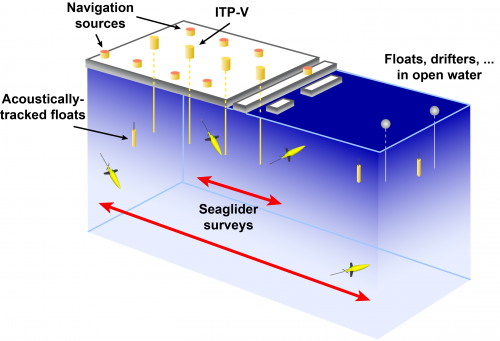 The Office of Naval Research (ONR) Arctic and Global Prediction Program is motivated by the significant sea ice retreat that has occurred in recent summers in the Arctic Ocean, and the implications for the U.S. Navy of the observed and predicted increase in maritime activity due to the diminishing summer ice cover. The overarching goal of the program is to improve the coupling of arctic system modeling and sea ice prediction capability at a variety of space and time scales in support of safe and efficient Navy mission planning and execution. To achieve this goal, the program supports basic research in three inter-dependent efforts:
The Office of Naval Research (ONR) Arctic and Global Prediction Program is motivated by the significant sea ice retreat that has occurred in recent summers in the Arctic Ocean, and the implications for the U.S. Navy of the observed and predicted increase in maritime activity due to the diminishing summer ice cover. The overarching goal of the program is to improve the coupling of arctic system modeling and sea ice prediction capability at a variety of space and time scales in support of safe and efficient Navy mission planning and execution. To achieve this goal, the program supports basic research in three inter-dependent efforts:
- Improve integrated atmosphere-ice-ocean-wave earth system models;
- Understand the physical environment, processes, and feedbacks in the Arctic Ocean; and
- Develop sensors, platforms, and communications for sustained operation and observation.
Research supported by core program funds covers a range of topics, including sea ice dynamics and mass balance; ocean hydrography and heat storage; atmospheric temperature profiles, circulation, and cloud properties; sea spray and icing; and high resolution eddy-resolving regional arctic climate modeling. In fiscal year 2012 (FY12), the first year of the program, 22 awards for 17 projects were made with core funds. Among these awards is a suite of six projects that will be integrated into a single atmosphere, ice, and ocean observing effort: Seasonal Ice Zone Reconnaissance Surveys (SIZRS). It is coordinated by the University of Washington Applied Physics Laboratory and takes advantage of U.S. Coast Guard Arctic Domain Awareness flights by C-130 aircraft out of Air Station Kodiak, Alaska.
Also in FY12, 11 awards for nine projects were made with Marginal Ice Zone (MIZ) Departmental Research Initiative (DRI) funds. The MIZ DRI is a five-year project (FY12 through FY16) with the following objectives:
- Collect and analyze a benchmark data set that resolves the key processes controlling the evolution of the marginal ice zone with sufficient spatial and temporal scope to capture a broad, representative range of environmental conditions;
- Understand the processes that govern the evolution of the marginal ice zone, identify key interactions and feedbacks in the ice-ocean-atmosphere system, and investigate how these might change with the predicted increased seasonality of the arctic sea ice cover; and
- Evaluate the ability of existing models to predict the seasonal evolution of the marginal ice zone and improve the parameterization of key processes to enhance seasonal forecast capability.
The DRI team has met twice and drafted a science and experiment plan that is expected to be released in late 2012. The field experiment, planned for spring through autumn 2014 in the Beaufort Sea and Canada basin, will involve the deployment and operation of a suite of sensors and platforms, including: ice mass balance and wave buoys, ice-tethered profilers, ocean flux buoys, automated weather stations, acoustic navigation and communication arrays, gliders and polar profiling floats, open ocean wave buoys, acoustic wave and current (AWAC) meters, waveriders, and wavegliders.

In February 2012, the program issued a call for planning letters for a new Departmental Research Initiative: Sea State and Boundary Layer Physics in the Emerging Arctic Ocean. This is also a five-year project (FY13 through FY17), with field experiments planned for spring through autumn of 2015 in the Beaufort and/or Chukchi seas. The Sea State DRI has the following provisional objectives:
- Develop a sea state climatology, identify factors affecting the spatial and temporal variability of sea state, and improve forecasting of waves on the open ocean and in the marginal ice zone;
- Develop a climatology and improved theory of wave attenuation/scattering in the sea ice cover;
- Use wave scattering theory directly in integrated arctic system models and indirectly to define an ice rheology for use in arctic system models; and
- Understand the wave-mediated physics of heat and mass transfer from the ocean to the atmosphere and the seasonal variability of fluxes during summer ice retreat and autumn ice advance.
For further information about the ONR Arctic and Global Prediction Program, go to http://www.onr.navy.mil/Science-Technology/Departments/Code-32.aspx or contact contributors of this article, Martin Jeffries (martin.jeffries [at] navy.mil) or Scott Harper (scott.l.harper [at] navy.mil).
